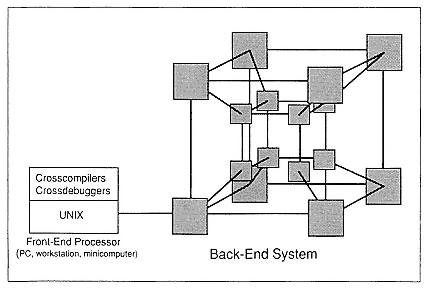Front End/Back End Versus Native UNIX
One key differentiator between most massively parallel systems and the successful mainstream parallel systems is the relationship of the development environment to the computer. In most massively parallel systems, the computer is an attached processor, or back end, to a front-end workstation, minicomputer, or personal computer (Figure 5). All software development and user interaction is done on the front end, whereas program execution runs on the back-end parallel system. BBN's early parallel processors, such as the Butterfly® I and Butterfly Plus systems, required such front ends. As we learned, there are several problems with this architecture, including
• Bottlenecks: the link between the front end and the back end is a potential bottleneck. It is frequently a local area network, such as Ethernet, with a very limited bandwidth compared with the requirements of high-end supercomputer applications.
Figure 5.
A front-end/back-end system.
• Debugging and tuning difficulties: because the software-development tools are separate from the parallel back end, it can be difficult to debug and tune programs. The tools on the front end cannot directly examine the memory of the back end and must rely on the back-end processors for information. If a program crashes some or all of the parallel nodes' kernels, the debugger may not be able to provide sufficient information.
• Slow development cycle: because development is done on a separate computer, the power of the parallel supercomputer is not available to run the development tools, such as the compiler. Also, executable program images must be downloaded into the back end, adding a step to the development cycle and further slowing down productivity.
• Multiple environments: while the front end typically runs UNIX, the back-end processors run a proprietary kernel. This requires the developer to learn two different environments.
• Limited kernel: the proprietary kernel that runs on the back-end processors does not provide all of the facilities that users expect on modern computers. These kernels provide little protection between tasks, no virtual memory, and few operating-system services.
Contrast this with modern supercomputers, mainframes, minicomputers, and workstations. All have native development environments, typically based on UNIX. This greatly simplifies development because the tools run on the same machine and under the same operating system as the executable programs. The full services of UNIX that are available to the programmer are also available to the executable program, including virtual memory, memory protection, and other system services. Since these systems are all shared-memory machines, powerful tools can be built for debugging and analyzing program performance, with limited intrusion into the programs operation.
Recent BBN parallel computers, such as the GP1000Ô and TC2000Ô systems, are complete, stand-alone UNIX systems and do not require a front end. The Mach 1000Ô and nXÔ operating systems that run on these computers contain a highly symmetric multiprocessing kernel that provides all of the facilities that users expect, including load balancing, parallel pipes and shell commands, etc. Since these operating systems present a standard UNIX interface and are compliant with the POSIX 1003.1 standard, users familiar with UNIX can begin using the system immediately. In fact, there are typically many users logged into and using a TC2000 system only hours after it is installed. This is in contrast to our earlier front-end/back-end systems, where users spent days or weeks studying manuals before running their first programs.
